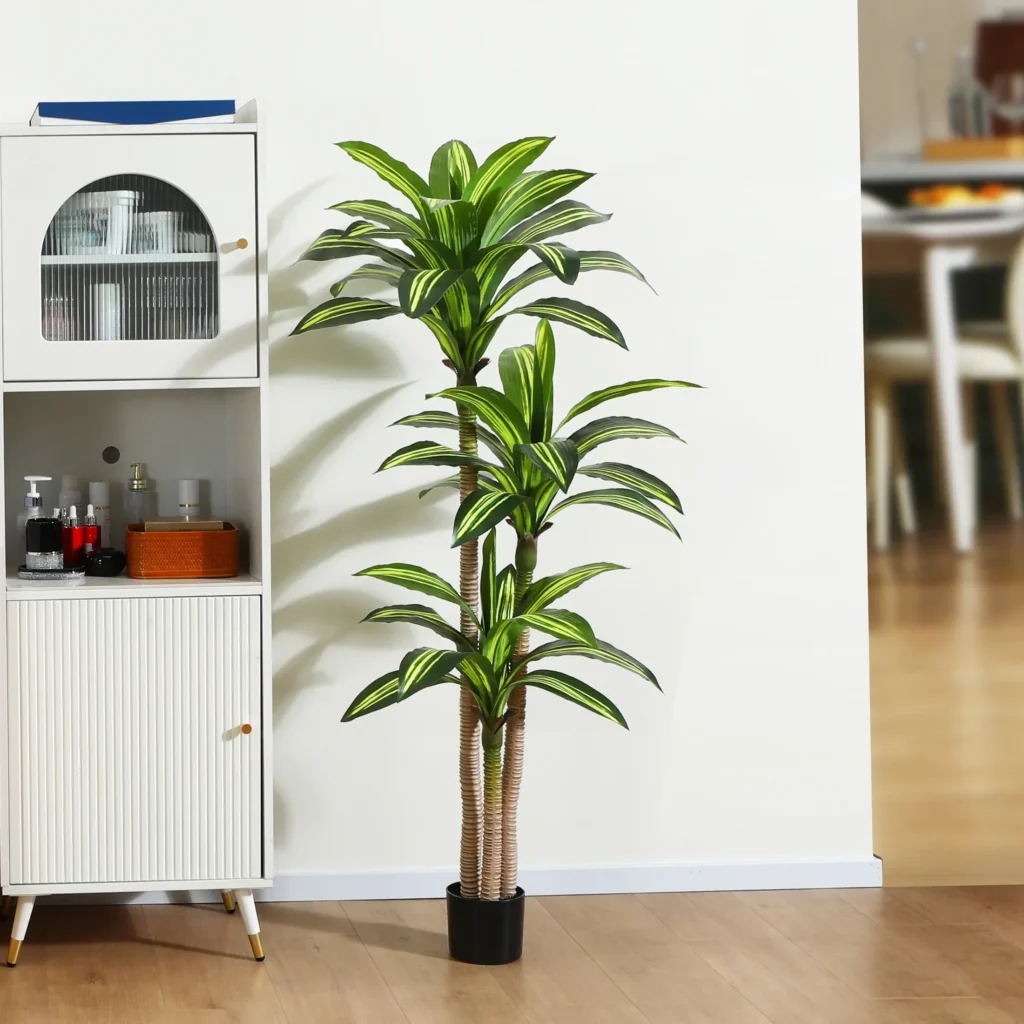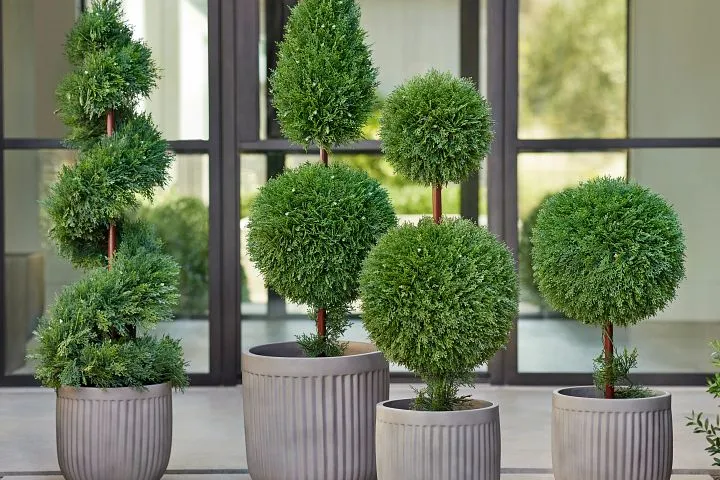Create a green oasis with our range of artificial plants. No watering needed! Browse our selection and bring nature indoors.
Introduction: Artificial Plants
Looking to add a touch of green to your space without the hassle of maintenance? Artificial plants provide a solution that is low-maintenance and long-lasting. In this blog post, we will explore the benefits of artificial plants and how they can enhance your home or office decor effortlessly.
Choosing the Right Artificial Plants
When selecting artificial plants for your home, consider factors such as size, style, and material to ensure they complement your decor seamlessly. Opt for high-quality silk or plastic plants that closely resemble their live counterparts for a more authentic look.
Factors to Consider:
- Size and Scale
- Style and Aesthetic
- Material and Quality
What are the benefits of using artificial plants in home decor?

Benefits of Using Artificial Plants in Home Decor
Artificial plants offer numerous benefits in home decor, making them a popular choice among homeowners and interior designers. Here are some of the key advantages of incorporating artificial plants into your home decor:
- Low Maintenance: Artificial plants require minimal care and maintenance compared to live plants. They don’t need watering, pruning, or fertilizing, making them ideal for busy individuals or those who lack a green thumb.
- Allergy-Free: Artificial plants are hypoallergenic, meaning they don’t produce pollen or other allergens that can trigger allergic reactions in some people. This makes them a great option for those who suffer from allergies or have pets that are sensitive to certain plants.
- Cost-Effective: Artificial plants are often more affordable than live plants, especially when considering the long-term costs of maintaining them. They also don’t require repotting or replacing due to natural growth or decay.
- Versatility: Artificial plants come in various shapes, sizes, and styles, allowing for greater flexibility in decorating different spaces. They can be used both indoors and outdoors, and can be easily moved around to suit changing decor needs.
- Durability: Artificial plants are resistant to wear and tear, and can withstand harsh weather conditions when used outdoors. They also don’t wilt or fade as quickly as live plants, ensuring a longer-lasting and more vibrant display.
- Aesthetically Pleasing: Advances in technology have made artificial plants increasingly realistic, making it difficult to distinguish them from live plants. They can provide the same visual benefits as live plants, such as improving mood and morale, as well as productivity and focus.
- No Mess: Artificial plants don’t shed leaves or require watering, eliminating the mess and cleanup associated with live plants.
- Year-Round Greenery: Artificial plants maintain their appearance and color year-round, providing consistent greenery regardless of the season or weather conditions.
When choosing artificial plants, consider factors such as material, size, and detail to ensure a realistic and high-quality product. Realistic leaves, for example, tend to have small holes, varying color gradation, shapes, and vein patterns, so look for artificial plants that mimic these features2.Incorporating artificial plants into your home decor can provide numerous benefits, from improving wellbeing to enhancing the aesthetic appeal of your living spaces. By choosing high-quality artificial plants that mimic the look and feel of live plants, you can enjoy the beauty of greenery without the hassle of maintenance or allergies.
How to choose the right artificial plant for your space?

To choose the right artificial plant for your space, consider the following factors based on the information from the provided sources:
- Size and Scale: Determine the appropriate size of the artificial plant based on the space where you intend to place it. Consider the height of your ceilings and the width of the floor space to ensure the plant fits proportionally.
- Material: Artificial plants are made from various materials like plastic, fabric, silk, or synthetic-fabric blends. Plastic plants offer defined details and durability, while fabric or silk plants provide a more natural look. Consider the material that best suits your desired aesthetic and maintenance preferences.
- Indoor vs. Outdoor Use: Decide whether you need an artificial plant for indoor or outdoor use. While some artificial plants can be used both indoors and outdoors, ensure that outdoor plants are UV protected to prevent fading and damage from the elements.
- Realism: Opt for artificial plants that closely resemble real plants to achieve a natural and realistic look. Premium brands like Artiplanto offer high-quality, realistic-looking artificial plants that can enhance your home decor.
- Fit with Existing Decor: Ensure that the artificial plant complements your existing decor by selecting a plant that fits appropriately in terms of size and style. Avoid choosing plants that clash with your decor or appear out of place.
- Personal Preference: Choose an artificial plant that resonates with you and adds meaning to your space. Whether it’s a faux Monstera plant, a spathiphyllum leaf plant, an artificial palm tree, or a tabletop fern plant, select a plant that speaks to your personal taste and style.
- Diversity in Selection: Create a diverse selection of artificial plants to mimic natural conditions and add visual interest to your space. Mix tall and short plants, wide and thin varieties to replicate a natural garden-like presentation.
By considering these factors and tips, you can confidently select the right artificial plant for your space, ensuring it enhances your decor, fits seamlessly into your environment, and brings a touch of greenery without the maintenance hassle of live plants.
What are the most popular types of artificial plants on the market?

The most popular types of artificial plants on the market include a variety of options that cater to different preferences and decor styles. Some of the sought-after artificial plants are:
- Fiddle-Leaf Fig: Known for its large, glossy leaves, the fiddle-leaf fig is a popular choice for adding a touch of elegance and greenery to indoor spaces.
- Rubber Tree: With its dark, waxy leaves, the rubber tree is a classic favorite that adds a sophisticated and lush look to any room.
- Bonsai: These miniature trees are prized for their intricate shapes and symbolism, making them a charming addition to home decor.
- Lemon Tree: Lemon trees bring a refreshing and citrusy vibe to interiors, adding a pop of color and a hint of Mediterranean charm.
- Jade Plant: Jade plants are known for their thick, succulent-like leaves and are believed to bring good luck and prosperity, making them a popular choice for home decor.
- Philodendron: This versatile plant comes in various sizes and shapes, with some varieties growing tall like trees, making a bold statement in any space.
- Hanging Plants: Hanging artificial plants, like tradescantia zebrina, are ideal for adding a touch of greenery to vertical spaces and creating a cascading effect.
- Cacti: Artificial cacti are trendy and low-maintenance options that add a touch of desert chic to modern interiors.
- Bird of Paradise: Known for its striking appearance, the artificial bird of paradise plant brings a tropical flair to homes with its unique leaf structure.
- Split-Leaf Monstera: This plant is a showstopper with its large, fenestrated leaves, adding a touch of tropical elegance to any room.
These popular artificial plants cater to various decor styles and preferences, offering a wide range of options to enhance the aesthetic appeal of homes without the need for maintenance or watering.
How to care for artificial plants to make them last longer?

To care for artificial plants and make them last longer, follow these tips:
- Cleaning: Dust and clean the plants regularly using a feather duster, microfiber cloth, or a soft brush. For a deeper clean, use hairspray or a purpose-made silk plant cleaner to remove dust and lint, leaving a healthy shine. For delicate or fragile plants, use a hairdryer on a low and cool setting to blow away dust and debris.
- UV Protection: If your artificial plants are exposed to direct sunlight, ensure they have a UV treatment or use a UV protection spray to prevent fading and cracking. UV resistant replica trees and plants can last well over a decade in ideal conditions.
- Maintenance: Limit direct sunlight exposure for indoor artificial plants. Turn them every week for even UV distribution. For outdoor plants, clean them regularly to remove dirt and debris that can cause staining and discoloration. Use a can of keyboard duster or a wet rag with gentle dish detergent to remove built-up grime.
- Arrangement: When placing artificial plants outdoors, consider using artificial flower beds, hanging window boxes, or artificial shrubs for borders or designated shapes. Placing mulch around faux shrubs makes them more realistic and adds to the illusion.
- Rotation: Keep a backup set of outdoor plants and rotate them for a few months at a time to extend their life. This is especially useful for indoor plants that are used outdoors during certain seasons.
- Storage: If possible, move artificial plants to a safer area, such as under an awning or shade, to prevent color fading and wearing. Turn the plants regularly to prevent fading on one side.
- UV Proof or UV Resistant Foliage: For all exterior applications of artificial trees, plants, and greenery, look for products that are UV proof or made with UV resistant foliage to best prevent fading.
By following these care tips, you can ensure your artificial plants maintain their vibrant appearance and last longer, providing a beautiful and low-maintenance addition to your home decor.
What are the disadvantages of using artificial plants in home decor?

Disadvantages of using artificial plants in home decor include:
- Lack of natural beauty: Artificial plants cannot replicate the natural beauty and charm of live plants, which can make a space feel less authentic and inviting.
- No air purification properties: Unlike live plants, artificial plants do not have the ability to purify the air or remove toxins, which can be beneficial for indoor environments.
- Questionable Feng Shui: Artificial plants may not have the same positive energy and natural elements associated with Feng Shui as live plants do, potentially creating an unnatural feel in the home environment.
- Not eco-friendly: Artificial plants are often made of non-decomposable materials, such as plastic, which can contribute to pollution and waste, and do not have the environmental benefits of live plants.
- Limited lifespan: Artificial plants can fade, discolor, or become damaged over time, requiring replacement or repair, whereas live plants can last indefinitely with proper care.
- Limited variety: While artificial plants come in a wide range of styles and designs, they may not be able to replicate the unique and diverse variety of live plants found in nature.
- Lack of authenticity: Artificial plants may not have the same emotional or aesthetic appeal as live plants, which can be important for some individuals or spaces.
When considering the use of artificial plants in home decor, it is important to weigh these disadvantages against the benefits, such as low maintenance and affordability, to determine the best fit for your needs and preferences.
Conclusion:
Artificial plants offer a versatile and low-maintenance way to introduce greenery into your home decor. By choosing high-quality plants, styling them thoughtfully, and caring for them properly, you can enjoy the beauty of nature indoors without the hassle of watering or pruning. Embrace the botanical trend with artificial plants and create a lush, inviting atmosphere in your living spaces.
FAQs :
A: Yes, artificial plants can thrive in any room, from the sunlit living room to the cozy bedroom. Just ensure they are dusted regularly to maintain their vibrant appearance.
A: To clean artificial plants, gently wipe the leaves with a damp cloth or use a soft brush to remove dust. For tougher stains, a mild soap solution can be used.
A: While some artificial plants are designed for outdoor use, it’s essential to check the manufacturer’s guidelines to ensure they are suitable for outdoor conditions.
